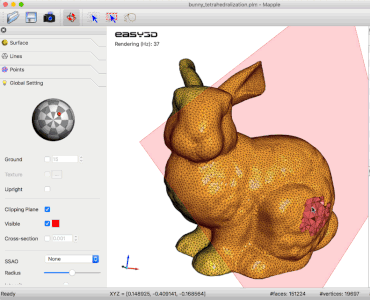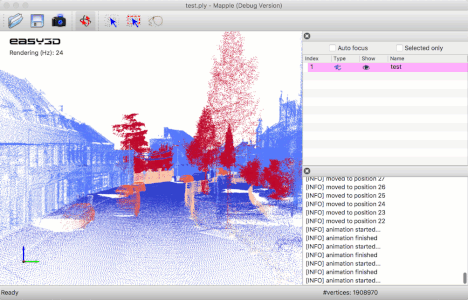LiangliangNan / Easy3d
Projects that are alternatives of or similar to Easy3d
Easy3D is an open-source library for 3D modeling, geometry processing, and rendering. It is implemented in C++ and designed with an emphasis on simplicity and efficiency.
Easy3D is intended for research and educational purposes, but it is also a good starting point for developing sophisticated 3D applications.
Key features
-
Efficient data structures for representing and managing 3D models such as point clouds, polygonal surfaces (e.g., triangle meshes), polyhedral volumes (e.g., tetrahedral meshes), and graphs. Easy to add/access arbitrary types of per-element properties. Non-manifoldness is automatically resolved when loading models from files ...
-
A set of widely used algorithms, e.g., point cloud normal estimation/re-orientation, Poisson surface reconstruction, RANSAC, mesh simplification, subdivision, smoothing, parameterization, remeshing, and more.
-
A bunch of rendering techniques, e.g., point/line imposters, ambient occlusion (SSAO), hard shadow (shadow maps), soft shadow (PCSS), eye-dome lighting (for rendering point clouds without normal information), transparency (average color blending, dual depth peeling), and more.
-
High-level encapsulation of OpenGL and GLSL for convenient and efficient rendering (based on modern and faster programmable-shader-style rendering, i.e., no fixed function calls). Client code does not need to touch the low-level APIs of OpenGL.
-
Step-by-step tutorials demonstrating various uses of the API, to get acquainted with the data structures, rendering techniques, and algorithms for 3D modeling and geometry processing.
-
Very easy to use as a callable library (usually only a few lines of code).
-
A viewer that can be used directly to visualize 3D scenes in various formats, which can also be easily extended.
-
A handy tool Mapple created out of the Easy3D library for rendering and processing 3D data.
| Scalar field | Polyhedral mesh | Keyframe animation |
|---|---|---|
 |
 |
 |
A quick glance
Any types of 3D drawables (e.g., points, lines, triangles, and thus point clouds, mesh surfaces, scalar fields, vector fields) can be rendered by writing a few lines of code with Easy3D. For example, the following code renders a point cloud as a set of spheres
// assume your point cloud has been loaded to the viewer
PointsDrawable* drawable = cloud->renderer()->get_points_drawable("vertices");
drawable->set_impostor_type(PointsDrawable::SPHERE); // draw points as spheres.
drawable->set_point_size(3.0f); // set point size
or as a set of surfels (i.e., 3D discs)
drawable->set_impostor_type(PointsDrawable::SURFEL);
By abstracting geometric elements as one of the above drawables, more general visualization (e.g., vector fields, scalar fields) can be done very conveniently.
Build
Easy3D depends on some third-party libraries. For the core functionalities and the basic viewer, all dependencies have
already been included in the distribution. Easy3D also optionally supports the use of Qt for GUI development.
You can switch on the following CMake option to include the examples and applications that use Qt (e.g.,
Tutorial_202_Viewer_Qt
and Mapple)
in your build:
EASY3D_ENABLE_QT
To build Easy3D, you need CMake and, of course, a compiler:
- CMake
>= 3.1 - a compiler that supports
>= C++11
Easy3D has been tested on macOS (Xcode >= 8), Windows (MSVC >=2015), and Linux (GCC >= 4.8, Clang >= 3.3). Machines nowadays typically provide higher supports, so you should be able to build Easy3D on almost all platforms.
There are many options to build Easy3D. Choose one of the following (or whatever you are familiar with):
- Option 1: Use CMake to generate Makefiles and then
make(on Linux/macOS) ornmake(on Windows with Microsoft Visual Studio). For example, on Linux or macOS, you can simply$ cd Easy3D $ mkdir Release $ cd Release $ cmake -DCMAKE_BUILD_TYPE=Release .. $ make - Option 2: Use any IDE that can directly handle CMakeLists files to open the
CMakeLists.txtin the root directory of Easy3D. Then you should have obtained a usable project and just build it. I recommend using CLion or QtCreator. - Option 3: Use CMake to generate project files for your IDE. Then load the project to your IDE and build.
Don't have any experience with C/C++ programming? Have a look at How to build Easy3D step by step.
Using Easy3D in Your Projects
This is quite easy, maybe easier than many other open-source libraries :-) You only need to add the following two lines
to your CMakeList file (don't forget to replace YOUR_APP_NAME with the actual name of your application) and point
Easy3D_DIR to your build directory of Easy3D when doing cmake. Then the requested easy3d libraries, include
directories, and relevant compile definitions of the easy3d libraries are visible and accessible to your project.
find_package(Easy3D REQUIRED)
target_link_libraries(YOUR_APP_NAME easy3d::core) # you may request more modules (e.g., viewer, algo)
Documentation
The documentation for Easy3D-v2.4.2 is available here.
The Easy3D Documentation is an on-going effort with more and more details being added. You can build the latest Easy3D
documentation from the source code.
Easy3D uses Doxygen (>= 1.8.3) to generate documentation from source code.
To build it from the source code, install Doxygen first.
Then, switch on the CMake option EASY3D_BUILD_DOCUMENTATION in the main CMakeList.txt. Finally, build the doc
target to generate the documentation.
License
Easy3D is free software; you can redistribute it and/or modify it under the terms of the GNU General Public License as published by the Free Software Foundation; either version 3 of the License or (at your option) any later version. The full text of the license can be found in the accompanying 'License' file.
Citation
If you use Easy3D in a scientific work, I kindly ask you to cite it:
@misc{easy3d2018nan,
title = {Easy3D: a lightweight, easy-to-use, and efficient C++ library for processing and rendering 3D data},
author = {Nan, Liangliang},
note = {\url{https://github.com/LiangliangNan/Easy3D}},
year = {2018},
}
Should you have any questions, comments, or suggestions, please contact me at [email protected]
Liangliang Nan
https://3d.bk.tudelft.nl/liangliang/
Dec. 8, 2018
Copyright (C) 2018




